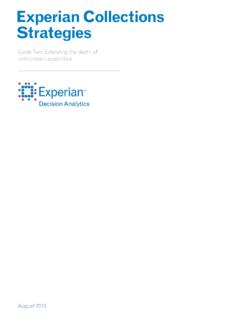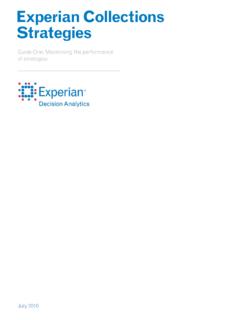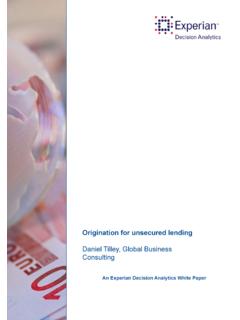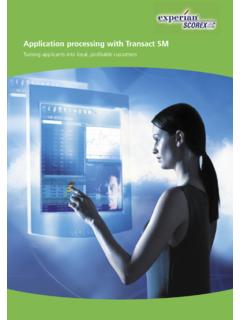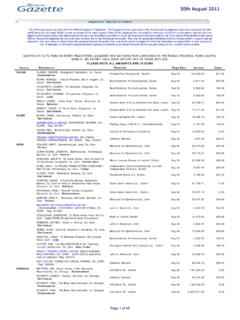Transcription of Identifying the Optimum Collections Strategy through the ...
1 Identifying the Optimum CollectionsStrategy through the use ofChampion Challenger AnalyticalTo o l sADecision Analytics briefing paper from ExperianDecember 2008 IntroductionThe economic downturn has highlighted that, after 15years of a static and a fairly forgiving collectionsenvironment, there are now significantly increasedpressures on consumers and their ability to meetrepayments on credit commitments. This has sparkedgreater fears among lenders about their exposurelevels to bad debts and, as a result, there is increasedfocus on the efficiency of their Collections it is recognised that the best customeracquisition risk management strategies need to beconstantly reviewed and amended to ensure that theyare performing optimally, the same process is not beingapplied to Collections strategies. This paper demonstrates the use ofchampion/challenger analysis as a means tocontinuously improve Collections performance in thisrapidly changing and challenging KeyworthPrincipal Consultant, Global ConsultingThe speed at which the credit crisis is developing into a global recession has takeneveryone unawares.
2 Now, set against a backdrop of collapsing house prices andrapidly growing unemployment levels, increased charge offs and mortgage defaultsare widespread as greater numbers of consumers struggle to service debtcommitments. But many Collections operations are struggling to cope with such a dramaticchange in economic and borrower dynamics. Historically, the design of debtmanagement systems and procedures, set up to support business through thegood times, has typically been aimed at achieving collection operational stabilityand predictability rather than allowing for flexibility and speed of implementingchange. This is now becoming a major issue as organisations try to address rapidlydet eriorating has been compounded by the fact that many Collections managers are,understandably, unwilling to take the risk of making widespread changes topreviously successful Collections strategies for fear of further losses. Instead,many focus on trying to increase throughput by making operational changes only;ramping up staffing resource, deploying new dialer technology or resorting toearlier debt sale and higher now, more than ever, Collections success depends on the ability oforganisations to ensure that at any given time, the most Optimum Strategy for eachIdentifying the Optimum Collections Strategy using Champion Challenger Tools - 2 The need for changeIdentifying the Optimum Collections Strategy using Champion Challenger Tools - 3debtor is being applied.
3 The challenge in such turbulent times is determining thatstrategy. The key is to develop test and learn methodologies that enable new strategies ortreatment paths to be tested in real time with no impact to ongoing collectionsactivity. This allows any downside risk of change to be minimised whilst allowing forthe upside benefits to be determined using factual evidence. Champion - challenger is an evolutionary process aimed at continually trying toimprove upon the current procedures and proactively addressing an ever-changingcollections world. In essence, it formalises the process of answering the what if questions Collections professionals ask themselves on a regular basis. Champion - challenger is terminology used to describe the way in which theexisting Collections Strategy , known as the champion, is routinely tested against analternative approach known as the challenger. To ensure accuracy, the challengershould be tested in a live environment but controlled to avoid financial loss.
4 Thusthe challenger is developed and designed using recent customer information andimplemented on a small, statistically robust sample with the results closelymonitored. If the challenger Strategy is shown to outperform the existing or championstrategy, the challenger Strategy can then be rolled out to a much larger proportionof the portfolio for further validation, or may even become the next champion Strategy on the majority of the portfolio. It is equally important that the successful new Strategy be deployed quickly so asto maximise benefits, whilst allowing for the design and implementation of the nextchallenger in constant search for improvement in process is critical in the currentdeteriorating environment, where a borrower s circumstance may changesignificantly, causing them to react and behave differently to varying contactstrategies. Adapting strategies regularly also prevents debtors from learning thestandard collection process and avoiding timely order to successfully develop a robust development process there are severalseparate stages that need to be which includes selection of the target process, documenting theexpect ed financial benefits and operational considerations of its the strategies to be challenged and explore current weaknesses the challenger Strategy and select the sample size and risk level the champion/challenger metrics and compare challenger group to control of results and promotion of challenger if appropriateWhat is Champion -Challenger testing?
5 The six keyconsiderations forChampion -Challenger testingIdentifying the Optimum Collections Strategy using Champion Challenger Tools - 41. PlanningThe first step in any Champion/Challenger process is to decide on the currentstrategy, procedure or work practice that will be challenged. Clear objectives for the challenger Strategy then need to be developed and agreedprior to the design and implementation phases. These objectives should articulatethe expected financial and operational improvements that should result from anychanges. Part of the process would also aim to plan the size of the test, how long itshould run for and how success will be measured. Insufficient focus on this stagecan lead to a resistance to change within the organisation. Objectives should alsobe clearly ReviewAn essential step, but one often overlooked, is the need to identify weaknesses inthe existing system, process and procedures that may be addressed in thechallenger Strategy design.
6 Collections processes are normally complex with multiple variables. By focusingon some key aspects it is often easier to assess the impact of the changes ratherthan trying to tackle the entire Collections process. For example, the challengerprocess under consideration might be the early contact schedule for a medium riskdebtor. Reviewing all the elements in detail such as timing, tone and frequency ofmail correspondence, timing and tone of first telephone call, relative experience ofthe agent, in conjunction with collection metrics, may highlight some unexpectedflaws in the existing Strategy . This review of specific current collection working practices and metrics can alsoidentify not only issues that contribute to an increased delinquency within thecollections environment, but may extend to other parts of the credit study by Experian identified that an increase in delinquency had severalcauses:The review stage therefore can identify specific issues that need to be addressedwithin a new Collections challenger, as well as Identifying contributing influencesthat may only be addressed further up-stream of DesignThe design phase of the Champion/Challenger process incorporates the keylearning from the review stage and balances this with the risk appetite of thebusiness.
7 Test accuracy, risk and chance of success can be optimised byconsidering the following: Clearly define challenger parametersThe parameters will depend on the specific area or process under review. TheIdentifying the Optimum Collections Strategy using Champion Challenger Tools - 5greater the level of changes, the greater the likely risk to the existing volume ofdebt being collected through customer inaction or a drop in staff include:-Refining segmentation criterion: such as number of missed payments,balance, risk scores or triggers from external bureaux-Determine appropriate actions & timing: changing type, timing, tone orfrequency of communication and/or when a debt is passed to a third party orsold. Identify exclusionsIdentify the special groups that will not be subject to testing but are run throughadministrative functions. Examples would include bankrupt, deceased, fraud groups may include those that need a heavy manual assessment to solveadministrative issues or to allocate to appropriate special treatment.
8 Exampleshere include first payment defaults and over-limit accounts within first month. Determine sample sizeWhen considering how to measure the success of a test it is common tocompare the test to an existing process hold-out sample (champion). The bestway to achieve an unbiased design and the most valid results is to assign arandom number that is used for test purposes to an account or customer. Theserandom numbers then allow the business to segment the account / customerbase into equal and random groups. The business should then determine thesize of the challenger test Strategy to be deployed, noting that the test groupsize will depend on the issue being tested. Since the challenger is to be compared to the established procedures the keymeasure is knowing how many different treatments are estimated to take placebetween the champion and challenger groups. The comparison between the twoapproaches is only valid where actions are markedly different. Typically the sizeof the test group can vary from 5% through to 25%.
9 It is important that accounts chosen for the champion challenger exercise havenot been used in any other recent challenger test. Their recent exposure tovariations in Collections process will not make them a true representativesample of the debtor database. An ongoing record should therefore be kept ofall challenger participants. Strategy Simulation / What If AnalysisWhilst the overall objective of Champion / Challenger testing is to test proposedstrategies in a controlled environment, it is crucial that the Collections Managerensures that a proposed challenger Strategy will not adversely impact theportfolio, either operationally or financially. Ideally, an understanding of theexpected results of the proposed Challenger is assessed by undertaking asimulation exercise. This Strategy deployment simulation is often referred to as What If analysis. What If analysis involves running the Strategy against a historical file ofaccounts / customers in an offline environment.
10 Distributions of volumes andrelated financial and risk measures of accounts falling into each actioncomponent of the Strategy can then be obtained. Analysis of these simulation results will allow the managers to gain a detailedinsight into the potential impact of the implementation of the new could include:- What volumes of automated letters and / or telephone calls will be generated as a result of the implementation of the Strategy ? Operational planning can then be undertaken to ensure that resources are available to deal with collection calls as required. Identifying the Optimum Collections Strategy using Champion Challenger Tools - 6- If the new Strategy was likely to result in an increase in debt outsourced for collection , what would be the cost impact of the commission to be paid and the operational impact of increased agency management time against the lift in monies collected?Asimulation is not a substitute for a Champion/Challenger test in a liveenvironment, but when the number of variables is high and the risk to existingcollections performance is significant, an offline analysis can improveoperational response and provide a more confident prediction of with Collections software professionals who have done similarChampion/Challenger tests elsewhere is also pertinent at this stage.
